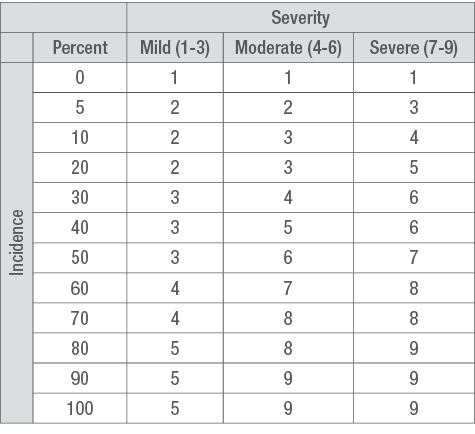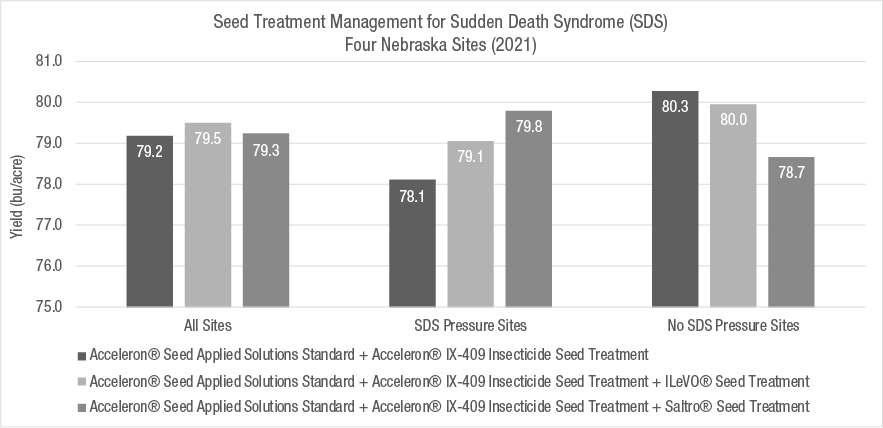
How to Manage Sudden Death Syndrome in Soybeans
Key Findings
- One of the most important, proactive management strategies a grower can make is using soybean products with the highest level of SDS resistance.
- Agronomic management, like crop rotation, minimizing compaction, and reducing excessive soil moisture, can help reduce the impact of SDS.
- While no significant yield improvement was found by adding ILeVO Seed Treatment or Saltro Seed Treatment, sites with observed SDS incidence showed a positive trend in yield response.
Trial Objective
- Evaluate a system-based approach for Sudden Death Syndrome (SDS) management in soybeans.
- Compare how 3 commercially available seed treatments suppress SDS and affect yield benefit.
- Explore the benefits of using a seed treatment along with selecting SDS-tolerant soybean products to help maximize yield potential in fields with a history of SDS.
Research Site Details
- Trials were conducted over 2 years at 4 locations — 1 location in 2020 and 3 locations in 2021.
| Nebraska Locations | Soil Type | Previous Crop | Tillage Type | Planting Date | Harvest Date | Potential Yield (bu/acre) | Seeding Rate (seeds/acre) |
|---|---|---|---|---|---|---|---|
| Battle Creek | Loamy Sand | Corn | Conventional | 5/14/21 | 10/05/21 | 70 | 150,000 |
| Utica | Silt Loam | Corn | Conventional | 5/10/21 | 9/28/21 | 90 | 150,000 |
| Hooper (Site 1) | Silty Clay Loam | Corn | No Till | 5/13/21 | 9/27/21 | 80 | 140,000 |
| Hooper (Site 2) | Silty Clay Loam | Corn | No Till | 5/15/20 | 10/01/20 | 80 | 135,000 |
- All trial locations had a history of SDS.
- Researchers targeted typical planting dates and used a single-replication, split-plot strip trial test. The product was the whole plot and seed treatments were the subplots.
- 3 soybean products, respectively, were planted in Utica, NE and Hooper, NE (Site 1) in 2021.
- 5 soybean products, respectively, were planted at Hooper, NE (Site 2) in 2020 and Battle Creek, NE in 2021.
- At each location, the soybean products were planted with 3 seed treatments:
- Acceleron® Seed Applied Solutions Standard* + Acceleron® IX-409 Insecticide Seed Treatment
- Acceleron Seed Applied Solutions Standard* + Acceleron IX-409 Insecticide Seed Treatment + ILeVO® Seed Treatment
- Acceleron Seed Applied Solutions Standard* + Acceleron IX-409 Insecticide Seed Treatment + Saltro® Seed Treatment
*Acceleron Seed Applied Solutions Standard is a combination of Acceleron® DX-109 Fungicide Seed Treatment/Acceleron® D-109 Fungicide Seed Treatment, Acceleron® DX-309 Fungicide Seed Treatment, and Acceleron® DX-612 Fungicide Seed Treatment/Acceleron® D-612 Fungicide Seed Treatment.
- Researchers controlled weeds in the same manner across the study (no foliar insecticides or fungicides were applied). Nutrients were managed by landowners according to their agronomic plans.
- All sites were irrigated using center point pivots.
- The trial used a rating system with 1 indicating good and 9 indicating poor. SDS field ratings were based on field incidence and severity at the R6 growth stage (average of three locations within each treatment) (Table 1).
Table 1. Sudden Death Syndrome Field Rating Scale

Understanding the Results
- Across the 4 locations, the combined average yields of the soybean products tested showed no yield response to the seed treatments (Figure 1 and Table 3).

- When the data was separated by SDS incidence, the locations with SDS (Table 2) had a positive yield response trend with the addition of ILeVO® Seed Treatment or Saltro Seed Treatment (Table 3).
- Locations with no SDS incidence (Table 2) showed no responses with the addition of ILeVO Seed Treatment. Researchers observed a slight negative trend in yield responses with the addition of Saltro Seed Treatment (Table 3).
Table 2. Average SDS Field Rating Across Soybean Products by Nebraska Location*
| Seed Treatment | SDS Field Rating by Location and (Year) | |||
|---|---|---|---|---|
| Battle Creek (2021) | Utica (2021) | Hooper (Site 1) (2021) | Hooper (Site 2) (2020) | |
| Acceleron® Seed Applied Solutions Standard + Acceleron® IX-409 Insecticide | 1 | 1 | 5.2 | 3.2 |
| Acceleron® Seed Applied Solutions Standard + Acceleron® IX-409 Insecticide + ILeVO® Seed Treatment | 1 | 1 | 4.2 | 2.8 |
| Acceleron® Seed Applied Solutions Standard + Acceleron® IX-409 Insecticide + Saltro® Seed Treatment | 1 | 1 | 4.3 | 2.4 |
|
*Data is separated by SDS pressure for three soybean seed treatments at four sites in Nebraska (one site in 2020 and three sites in 2021). Acceleron® Seed Applied Solutions Standard is a combination of Acceleron® DX-109 Fungicide Seed Treatment/Acceleron® D-109 Fungicide Seed Treatment, Acceleron® DX-309 Fungicide Seed Treatment, and Acceleron® DX-612 Fungicide Seed Treatment/Acceleron® D-612 Fungicide Seed Treatment. | ||||
Table 3. Average Soybean Yield and SDS Rating Across Soybean Products Used in Trial at Each Site*
| Site Category | Seed Treatment | Average Yield (bu/acre) | SDS Field Rating |
|---|---|---|---|
| All Sites | Acceleron® Seed Applied Solutions Standard + Acceleron® IX-409 Insecticide | 79.2 | 2.5 |
| Acceleron® Seed Applied Solutions Standard + Acceleron® IX-409 Insecticide + ILeVO® Seed Treatment | 79.5 | 2.1 | |
| Acceleron® Seed Applied Solutions Standard + Acceleron® IX-409 Insecticide + Saltro® Seed Treatment | 79.3 | 2.1 | |
| SDS Pressure Sites | Acceleron® Seed Applied Solutions Standard + Acceleron® IX-409 Insecticide | 78.1 | 3.9 |
| Acceleron® Seed Applied Solutions Standard + Acceleron® IX-409 Insecticide + ILeVO® Seed Treatment | 79.1 | 3.3 | |
| Acceleron® Seed Applied Solutions Standard + Acceleron® IX-409 Insecticide + Saltro® Seed Treatment | 79.8 | 3.2 | |
| No SDS Pressure Sites | Acceleron® Seed Applied Solutions Standard + Acceleron® IX-409 Insecticide | 80.3 | 1.0 |
| Acceleron® Seed Applied Solutions Standard + Acceleron® IX-409 Insecticide + ILeVO® Seed Treatment | 80.0 | 1.0 | |
| Acceleron® Seed Applied Solutions Standard + Acceleron® IX-409 Insecticide + Saltro® Seed Treatment | 78.7 | 1.0 | |
*Data is separated by SDS pressure for three soybean seed treatments at four sites in Nebraska (one site in 2020 and three sites in 2021). Acceleron® Seed Applied Solutions Standard is a combination of Acceleron® DX-109 Fungicide Seed Treatment/Acceleron® D-109 Fungicide Seed Treatment, Acceleron® DX-309 Fungicide Seed Treatment, and Acceleron® DX-612 Fungicide Seed Treatment/Acceleron® D-612 Fungicide Seed Treatment. | |||
- Individual responses to seed treatments varied by soybean product. But, because of the limited replications of each soybean product across locations, analysis was performed as an aggregate of soybean products.
Consult with your local sales representatives and agronomists to find out which soybean product will best manage SDS on your farm. Optional seed treatments can provide improved protection from SDS.